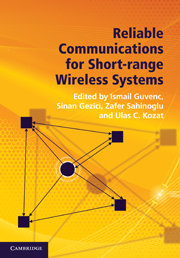Book contents
- Frontmatter
- Contents
- List of contributors
- 1 Short-range wireless communications and reliability
- Part I High-rate systems
- Part II Low-rate systems
- 6 ZigBee networks and low-rate UWB communications
- 7 Impact of channel estimation on reliability
- 8 Interference mitigation and awareness for improved reliability
- 9 Characterization of Wi-Fi interference for dynamic channel allocation in WPANs
- 10 Energy saving in low-rate systems
- Part II Selected topics for improved reliability
- Index
6 - ZigBee networks and low-rate UWB communications
from Part II - Low-rate systems
Published online by Cambridge University Press: 01 June 2011
- Frontmatter
- Contents
- List of contributors
- 1 Short-range wireless communications and reliability
- Part I High-rate systems
- Part II Low-rate systems
- 6 ZigBee networks and low-rate UWB communications
- 7 Impact of channel estimation on reliability
- 8 Interference mitigation and awareness for improved reliability
- 9 Characterization of Wi-Fi interference for dynamic channel allocation in WPANs
- 10 Energy saving in low-rate systems
- Part II Selected topics for improved reliability
- Index
Summary
In this chapter, technologies and standards for low data rate communication systems for wireless personal area networks (WPANs) and wireless sensor networks (WSNs) are discussed. First, ZigBee technology based on the IEEE 802.15.4 standard, and then low-rate UWB technology based on the IEEE 802.15.4a standard are reviewed. Finally, some of the related standards that are being developed by IEEE 802.15 working groups (WGs) are summarized.
Overview and application examples
Together with the recent advances in radio frequency (RF) and MEMS integrated circuit technologies, wireless sensors are becoming cheaper, smaller, and more capable. Through WSNs, a wealth of new applications are becoming possible, including surveillance, building control, factory automation, and in-vehicle sensing [1]. In the near future, we will observe that buildings, furniture, cars, streets, highways, etc. will all comprise WSNs. The Wireless World Research Forum (WWRF) envisions that by the year 2017 about 7 billion people in the world are expected to be using 7 trillion wireless devices, and the majority of these devices will be short-range wireless devices including small-size, low-power, low-complexity WSNs [2]. In order to provide a better picture of potential WSN applications, recent example applications in the literature are listed in Table 6.8 towards the end of the chapter.
WSNs may be typically deployed in large numbers and the network may need to operate for an extensive duration on the same battery. Therefore, key requirements for WSN transceivers include low-cost sensor nodes, small form factors, and low energy consumption.
- Type
- Chapter
- Information
- Reliable Communications for Short-Range Wireless Systems , pp. 139 - 167Publisher: Cambridge University PressPrint publication year: 2011
- 1
- Cited by

